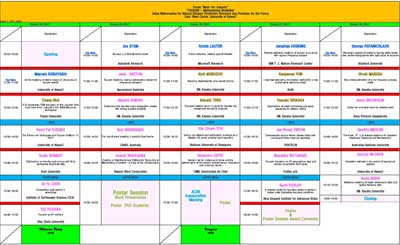Program
Abstract
Keynote address
Jonathan HOSKING(IBM T. J. Watson Research Center, USA)
Towards Statistical Modeling of Tsunami Occurrence with Regional Frequency Analysis
Regional frequency analysis is a statistical method for frequency estimation of extreme environmental events. Data for several sites are combined to improve the estimates of event frequencies at any one site. The computations are typically based on L-moments, which are summary statistics that have good properties of efficiency and robustness for describing data from heavy-tailed probability distributions. These methods have has been adopted by government agencies in the U.S.A. and the U.K. for frequency estimation of extreme floods and rainfall events. Recent research has extended the use of regional frequency analysis to estimation of earthquake magnitudes. I will describe this work, and include some indications of how this approach could be adapted to the task of magnitude prediction for tsunamis.
Marcelo KOBAYASHI(Mechanical Engineering, University of Hawai'i at Mānoa, USA)
On the Modeling of Debris Impact on Structures on Tsunami Events
Relatively little research has been devoted to tsunami-driven debris, although recent tsunamis have illustrated the potential for structural damage from such debris. In this talk, we will present results from theoretical modeling and simulations of debris impact on structural elements during tsunami attacks. The theoretical modeling includes the analytical solution of a simplified model that can be used for design and reliability studies, and a fully 3D computational model of the floating debris.
Kristin LAUTER (Microsoft Research, USA)
Cloud Computing: Hedging against Disaster
For many scenarios such as disasters, cloud storage and services provided by remote data centers can help assure continuity and availability of valuable data and information.
This talk will explain how we can design cloud infrastructures which we can trust with our private data. This is especially important for sensitive data such as medical or financial records. This talk will highlight emerging cryptographic techniques which can help to secure the cloud.
George PAPANICOLAOU(Mathematics Department, Stanford University, USA)
Stochastic Aspects of Modeling Shallow Water Waves Over Random Topographies with Application to Tsunamis
The shallow water equations over a variable topography have been used successfully for many years and have been analyzed and simplified in several special situations. I will review briefly these equations and their applicability and I will then introduce a large deviations approach to their study. This can deal with model as well as topographic uncertainty and gives estimates of small probabilities of rare but very destructive events in regimes that are out of reach by direct numerical simulations.
Jos STAM(Autodesk Research, CANADA)
Nucleus: A Unified Dynamics Solver
In this talk I will present some research I have done over the past few years in developing a unified dynamics solver for computer graphics. Currently many solvers are specialized for a given phenomenon such as fluid flow, cloth, rigid bodies, hair, etc. Having these different solvers interact is sometimes problematic. We propose to model all matter as a linked particle system having the topology of a simplicial complex. The dynamical complex evolves due to external forces like gravity and constraints such as collisions and internal deformation energies. We use a solution scheme that iteratively updates the velocities to achieve all constraints. Key to the stability of our system is to interleave the solve for the different constraints. The talk will cover the main ideas and ingredients of our solver and will be accompanied with live demonstrations. We will also show applications beyond the area of computer graphics. This includes physics-based shape design for architecture and nano-scale self-assembly of DNA strands.
Invited talks
Bob ANDERSSEN(CSIRO, AUSTRALIA)
Mathematical Modelling in the Science and
Technology of Food Security
As well as earthquakes, tsunamis and nuclear disasters, biological catastrophes have posed major challenges for human survival, such as the potato famine and wheat rust. Food security depends heavily on a variety of R&D plant breeding activities, such as the breeding of pest and disease resistant plant which guarantee the quality of the end product that they are utilized to make. The deeper understanding of plant molecular biology resulting from the DNA revolution is enhancing the science that underpins modern plant breeding. The talk will discuss this from the point of view of modelling antiviral resistance in plants.
Armin BRUDERLIN
(Sony Pictures Imageworks, USA)
Digital Hair and other Tools for Entertainment
At Sony Pictures Imageworks, we have been developing proprietary computer software in the process of creating digital effects for live-action and computer- animated feature movies. Whereas some applications are more data and system driven such as our render queue management, asset tracking and remote site synchronization, many tools have significant mathematical elements to support modeling, character rigging, animation, effects, rendering, and compositing. However, in entertainment as opposed to visualization or simulation of real life phenomena, pure math or physics alone often cannot generate the desired outcome, but a mixture of solutions encapsulating robust algorithms, useful tricks, and skilled artist contributions are necessary.
In this talk I will discuss some of our proprietary tools. In particular, I will present some aspects of our digital hair and fur pipeline, which is also used now as a more general arbitrary geometric instancing system. For example, in the Smurf's movie, besides the head hair of Smurfette and beard of Papa Smurf, it was also used to generate the "peach fuzz" on the skin and clothing of the Smurfs characters, and to instance most of the flowers and vegetation in the environment of the Smurf's village.
Qi-fu CHEN(Institute of Earthquake Science, CHINA)
Computation Applications in Seismology
Kwok Fai CHEUNG(Department of Ocean and Resources Engineering, University of Hawai'i at Mānoa, USA)
The Tohoku-oki Earthquake and Tsunami of March 11, 2011
The Tohoku-oki great earthquake of MW 9.0 ruptured the megathrust fault offshore of Miyagi and Fukushima in northeastern Honshu on March 11, 2011. The extensive global seismic networks and the dense geodetic networks allow reconstruction of the rupture sequence and validation of the earth surface deformation. The presentation will focus on modeling of the tsunami from the rupture sequence as well as validation of the model results with deep-ocean buoy data around the Pacific and recorded runup in Japan and Hawaii.
Yasuaki HIRAOKA(IMI, Kyushu University, JAPAN)
Applications of Sheaf Cohomology and Exact Sequences to Network Coding
In this talk, we introduce a novel application of sheaf cohomology --- a mathematical tool for collating local algebraic data into global structures --- to network coding problems. After recalling the definition of sheaves, we introduce network coding sheaves for a general multi-source network coding scenario, and consider various forms of sheaf cohomologies. The main theorem states that network coding sheaf cohomology is equivalent to information flows for the network coding. This theorem is then applied to several practical problems in network codings such as maxflow bounds, global extendability, network robustness, and data merging; these applications all follow from exact sequences of sheaf cohomology.
Cheng HUA(Fudan University, CHINA)
2-D viscoelastic FEM Simulation on the Longmen Shan Fault Zone which Ruptured in the 2008 Wenchuan Earthquake
The 2008 Wenchuan (M=8.0) earthquake occurred on the Longmen Shan Fault zone, which was thought to be without the possibility of earthquake. Based upon the regional tectonic characteristics of the Longmen Shan area, a dynamic model is studied by means of viscoelastic finite element method. The characteristics of the stress fields and the deformation rate fields are analyzed for the dynamical mechanisms of the earthquake.
Alejandro JOFRÉ (Centro de Modelamiento Matemático, Universidad de Chile, CHILE)
Seismic risk for underground mines and the determination of the seismic moment tensor: theoretical and numerical results
The massive extraction of copper in underground mines through block or panel caving process induces seismic activity. For example, high rates of extraction increase seismic activity. One of the key issue for designing an underground mine is how strong should be the fortification in the tunnels for supporting different levels of extraction and seismic activity. In this setting, a seismic event induced by mineral extraction can be considered a consequence of a slippage on an active geological fault. In this talk we present first the problem of recovering the moment tensor-characterizing information about the source-associated to such events from measurements on a seismometer network usually installed in underground mines. We consider then the problem of identifiability and stability. Second, we develop a seismic risk analysis connecting level of production with seismic activity and level of fortification. Finally, we present some theoretical result as well as numerical simulations associated to this issue.
Masato KIMURA(IMI, Kyushu University, JAPAN)
Continuous and Discrete Crack Propagation Models with Energy Gradient Property
We consider some crack propagation models of energy gradient type using the idea of phase field for damage of the elastic material. A partial differential equation model and a discrete mass-spring model are presented with some numerical simulations.
Yuji KODAMA(Department of Mathematics, Ohio State University, USA)
Tsunami as KP-Solitons
Based on the recent data on Tohoku tsunami 2011, I will discuss the phenomena using the KP theory, and in particular, I will show that the KP solitons may explain large amplification observed in the tsunami.
Jae Ryong KWEON(Department of Mathematics, POSTECH, KOREA)
Compressible Viscous Navier-Stokes Flows over Cornersand Some Numerical Examples.
I will talk about existence and regularity of solutions to the compressible Navier-Stokes equations on bounded domains with corners. Some related numerical simulations is presented based on the finite element method.
Hiroki MASUDA(IMI, Kyushu University, JAPAN)
Very Simple Estimation of a Non-Gaussian Process Model
Non-Gaussian processes can form a rich class of statistical models. They have been used in many application fields dealing with time-varying phenomena, such as signal processing, actuarial science, and mathematical finance. We will provide a pretty practical estimation procedure for a class of non-Gaussian processes observed at high-frequency, with a rigorous asymptotic distribution theory. The estimators obtained exhibit, despite of its simplicity, a rather reliable performance.
Geoff MERCER(National Centre for Epidemiology and Population Health, Australian National University, AUSTRALIA)
The three 'R's of disease modelling for disasters: Readiness, Response and Retrospection
Here we describe how mathematical modelling can help in the planning, response and understanding of disease transmission during a disaster. Infectious disease outbreaks are associated with many natural disasters such as earthquakes and tsunamis due to damage to the public health infrastructure such as water supply and sewerage systems. In addition a new or re-emerging disease can be considered a disaster if it has a large enough impact on the population.
Planning for disasters is a critical component of the response to that disaster. We will give examples of how mathematical modelling of disease transmission is used in the planning for disease outbreaks. These models give public health authorities valuable information about the likely size and speed of outbreaks, and the impact on the health system. Different control or coping strategies can be investigated and assessed for both their benefit and cost. Once an infectious disease outbreak is underway it is important that public health authorities respond in a suitable way. Real time modelling, as data on the spread of the disease becomes available, can aid this process. Unfortunately, this is not used as much as it could be and issues around this will be discussed. Once an outbreak is over modelling provides a mechanism to better understand what happened during the outbreak and how this can be fed back into the future planning process. Examples from recent and ongoing disease outbreaks such as pandemic influenza, dengue fever, cholera, hepatitis and tuberculosis will be used throughout this presentation.
Kirill MOROZOV(IMI, Kyushu University, JAPAN)
Improving Dependability Using Secret Sharing
We will present some mathematical techniques for constructing secret sharing schemes, and then we will show their applications to improving safety and reliability of distributed information storage.
Junichi NAKAGAWA(Nippon Steel Corporation, JAPAN)
Creating an Interdisciplinary Platform for Taking Aim at Mathematical Innovation -A Case of Soil Contamination -
For this platform, mathematicians and engineers have come together, contemplating social problems and taking voluntary actions. The
scientific topic is the issue of anomalous diffusion in soil. The approach is highly diverse, with a boundary that encompasses mathematics, engineering, and industry.
Ryuei NISHII(IMI, Kyushu University, JAPAN)
Statistical Modeling of Hyper-Dimensional Data and Spatio-Temporal Data
Hyper-dimensional data have become observable by the development of data
acquisition, transmission, and accumulation technology. Direct applications
of ordinary statistical technology are, however, not always successful for
such huge sizes of digital data. We discuss statistical methods introduced
to analyze such data observed in environmental science and human
engineering.
The talk is based on the joint work with Pan Qin.
Boris PAVLOV(New Zealand Institute for Advanced Study, NEW ZEALAND)
A Solvable Model for Boundary Stress on Tectonic Plates under Dissipative Boundary Conditions
Due to the changes of the rotation speed of Earth, the tectonic plates slide on a liquid underlay, hitting each other at the relatively small places of the contact - active zones,- generating a localized boundary stress. The stress causes the shift of the eigenvalues of the tectonic plates, which are observed as squares of the frequencies of the seismo-gravitational oscillation of the plates with periods circa 0.5 - 1 hour. In our previous paper [1] we assumed that the oscillations of unperturbed
tectonic plates are generated by the biharmonic wave equation $u_{tt}=\nu2 \Delta2 u$ with Neumann conditions $\frac{\partial \Delta u}{\partial n}\big|_{\Gamma}=\frac{\partial u} {\partial n}\big|_{\Gamma} = 0$ at the boundary $\Gamma$, and the localized stress at the boundary point $\gamma\ in \Gamma$ defined by a $3\times 3$ hermitian matrix, playing the role of the Saint-Venant parameter. Fitting the parameter based on monitoring the seismo-gravitational oscillations one can estimate an amount of the elastic energy stored in the perturbed plate. Now we consider a biharmonic operator $B$ with {\it dissipative} boundary condition and construct the solvable model $B_{\beta}$ of the boundary stress as a generator of the Lax-Phillips semigroup of the unitary group defined by the zero-range perturbation ${\mathcal{B}}_{\beta}$ of the selfadjoint dilatation ${\mathcal{B}}$ of of $B$. Similar approach can be developed for more representative model with the the biharmonic operator substituted by a generator of oscillations of the plate with liquid underlay taken into account, see [2].
[1] L. Petrova, B. Pavlov {\it Tectonic plate under a localized boundary stress: fitting of a zero-range solvable model.} In: Journal of Physics A, {\bf 41} (2008) 085206 (15 pp).
[2]Y. Fukumoto, B. Pavlov, L. Petrova. {\it Saint-Venant parameters of the tectonic plate in the dissipative environment under a localized boundary stress.} In preparation.
Jane SEXTON (Geoscience Australia, AUSTRALIA)
Tsunami modelling: making mathematics relevant to emergency managers
Geoscience Australia has established collaborative partnerships with state and federal emergency management agencies to support better preparedness and to improve community awareness of tsunami risks. The partnerships are based on effective communication between scientists, emergency managers, data custodians and the community as well as the development and implementation of a best practice tsunami risk modelling methodology. Community engagement workshops have led to the formulation of tsunami preparation and emergency response plans as well as increased awareness of the science of tsunami risk.
Geoscience Australia's tsunami risk modelling methodology has undergone continuous development since 2005 and relies on understanding the sources that generate tsunamis, the propagation of tsunamis through the ocean, as well as their behaviour as they reach the coast and flow onshore. This knowledge is then combined with community exposure and vulnerability information to assess the potential impact of an event and to devise appropriate mitigation strategies.
This presentation will outline the elements of the partnerships, the scientific process and its limitations, and how this work has led to safer Australian communities.
Kunio SHIMIZU(Department of Mathematics, Faculty of Science and Technology, Keio University, JAPAN)
Distributions on the Disc and Annulus with fit to Earthquake Magnitude Data
A multivariate generalization of the M\"{o}bius distribution on the disc proposed by Jones (2004) is considered by Uesu and Shimizu (2010). Fit to earthquake magnitude data is studied for the three dimensional case. Skew distributions on the disc and annulus are proposed.
Atsushi TERO(IMI, Kyushu University, JAPAN)
Transport Network Which is Robust for Disaster but Inexpensive Learned by Organism
In a time of disaster transpotation and information networks are very important. But the transportation network is damaged by the disaster. On the other hand, in usual day the robust network is denied because of their cost. Here I explain the network formation that has the balance of the robustness and cost by learning from the organism which survived the severe struggle for existence.
Kim Chuan TOH(Department of Mathematics,
National University of Singapore, SINGAPORE)
Solving Log-Determinant Optimization Problems by a Newton-CG Primal Proximal Point Algorithm
We propose a Newton-CG primal proximal point algorithm for solving large scale log-determinant optimization problems. Our algorithm employs the essential ideas of the proximal point algorithm, the Newton method and the preconditioned conjugate gradient solver. Focusing on the problem of maximum likelihood sparse estimation of a Gaussian graphical model we demonstrate that our algorithm performs favorably compared to existing state-of-the-art algorithms and is much more preferred when a high quality solution is required for problems with many equality constraints.
Masahiro WATANABE(Application Research and Development Division Next Generation Technical Computing Unit Fujitsu Ltd., JAPAN)
Tsunami Simulation on 3D Geographical Data and Realistic Visualization Techniques
We are developing a tsunami simulator based on the smoothed particle hydrodynamics (SPH) method and a highly accurate visualization
techniques to inform residents in coastal area of risks of tsunami by showing a scene of surging wave. In this presentation, we will introduce the simulaion and visualization techniques we have developed. Then, we will give a short demonstration of our tsunami simulation.
George WILKENS (Department of Mathematics, University of Hawai'i at Mānoa, USA)
Geometric Methods in the Control of Mechanical Systems
Differential geometry provides a natural environment for extending the analytical tools of calculus from Euclidean vector spaces to non-Euclidean spaces. By its very nature, differential geometry focuses on intrinsic and coordinate-free representations of its underlying objects. This freedom from coordinates often clarifies the underlying structure of a model and guides the researcher to ask the right questions about the model. This explains, in part, why differential geometry has been successfully incorporated into many areas of application oriented mathematics, such as the control of interconnected mechanical systems. By surveying the geometric methods used in this particular applied problem, we will indicate the overall utility of differential geometry to the physical world.
Sangwoon YUN(School of Computational Sciences
, KIAS, KOREA)
Linearized Alternating Minimization Method for a New Multiplicative Denoising Model
In a coherent imaging system, such as synthetic aperture radar (SAR), the observed images are contaminated by multiplicative noise. Due to edge preserving feature of the total variation (TV), variational models with TV regularization have attracted much interest in removing multiplicative noise. However, the fidelity term of the variational model, based on maximum a posteriori estimation, is not convex and so it is usually difficult to find a global solution. Hence, the log function is used to transform the nonconvex variational model to the convex one. In this talk, instead of using the log, we exploit m-th root function to relax the nonconvexity of the variational model. We propose to use a linearized proximal alternating minimization algorithm which requires no inner iterations. The proposed model for multiplicative denoising of SAR images shows overall better performance than the convex model based on the log transformation.







